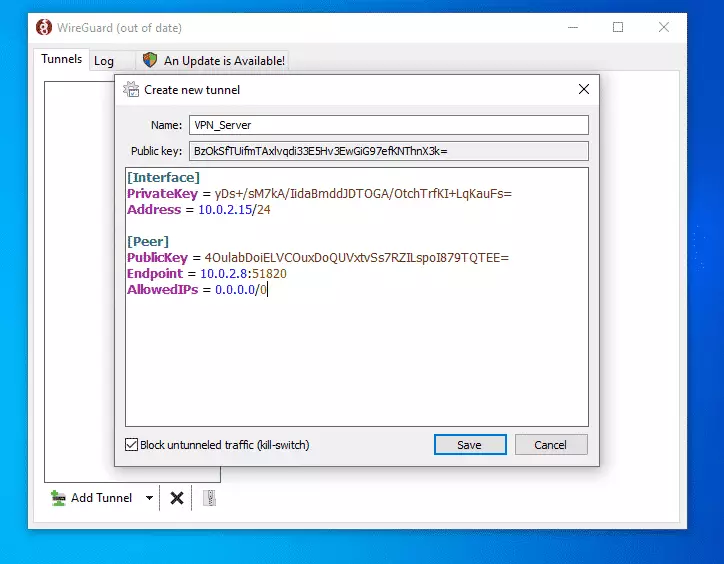This brief tutorial shows students and new users how to install WireGuard VPN Server on Ubuntu 18.04 | 20.04.
WireGuard is a novel VPN (Virtual Private Network) that runs inside the Linux kernel. It is easy to install and configure, and if you’re looking for great open-source VPN software to secure your communication, WireGuard is a great place to start. Ubuntu Linux OS is a great Linux operating system for beginners.
It’s an open-source Linux operating system on desktops, laptops, servers, and other devices. If you’re a student or a new user, you will find that the most accessible place to start learning Linux is Ubuntu.
Installing WireGuard VPN Server on Ubuntu lets you quickly and securely set up a VPN server and connect to it from any device running WireGuard client software. This can be useful for protecting your online privacy, accessing restricted content, or connecting securely to a remote network.
To get started with installing and configuring WireGuard, follow the steps below:
Install WireGuard Server
WireGuard has a well-maintained PPA repository. Use this repository to install WireGuard so that when newer versions are available, your system can install them.
To add WireGuard PPA and install it from there, run the commands below to get Ubuntu updated and install some essential packages.
sudo apt update sudo apt install software-properties-common
Next, add the PPA repository and install WireGuard. Press Enter when prompted. This will install the repository file and now the system’s package sources.
The second command installs WireGuard.
sudo add-apt-repository ppa:wireguard/wireguard sudo apt install wireguard
After installing WireGuard, you should see a similar message as shown below:
wireguard: Running module version sanity check. Original module No original module exists within this kernel Installation Installing to /lib/modules/5.3.0-46-generic/updates/dkms/ depmod… DKMS: install completed.
WireGuard is now installed and ready to be configured.
Configure WireGuard
After installing WireGuard, follow the steps below to configure it.
First, create private and public keys. These keys are vital to the operation of a VPN for secure communications.
Run the commands below to generate the public | and private key pair.
wg genkey | sudo tee /etc/wireguard/privatekey | wg pubkey | sudo tee /etc/wireguard/publickey
These essential files will be generated and stored in the /etc/wireguard directory.
After generating the key pair above, your next task will be to create a tunnel device that will be used to route the VPN traffic.
This can be done using the ip or wg command.
You can create a tunnel file and add its configurations for easier management.
Run the commands below to create a tunnel file called wg0.conf
sudo nano /etc/wireguard/wg0.conf
Then copy and paste the lines below into the file and save.
[Interface] Address = 10.0.2.8/24 SaveConfig = true ListenPort = 51820 PrivateKey = paste server's private key here PostUp = iptables -A FORWARD -i %i -j ACCEPT; iptables -t nat -A POSTROUTING -o enp0s3 -j MASQUERADE PostDown = iptables -D FORWARD -i %i -j ACCEPT; iptables -t nat -D POSTROUTING -o enp0s3 -j MASQUERADE
Save the file and exit.
Details of the file above:
- Address = the server network interface connected to the Internet. It can be IPv4 or IPv6
- PrivateKey = private key creates above stored in the /etc/wireguard/privatekey.
- ListenPort = incoming port WireGuard listens on
- enp0s3 = should match the interface name on the server. Some systems will have different names for their interfaces.
To find your network interface details, run the commands below:
ip addr
It should output similar lines as shown below:
enp0s3: mtu 1500 qdisc fq_codel state UP group default qlen 1000 link/ether 08:00:27:af:cf:6b brd ff:ff:ff:ff:ff:ff inet 10.0.2.8/24 brd 10.0.2.255 scope global dynamic noprefixroute enp0s3 valid_lft 932sec preferred_lft 932sec inet6 fe80::4b36:b8a6:fdc9:ee72/64 scope link noprefixroute valid_lft forever preferred_lft forever
After that, run the command below to activate the tunnel interface and bring it up.
sudo wg-quick up wg0 sudo systemctl enable wg-quick@wg0
That should output similar lines as shown below:
[#] ip link add wg0 type wireguard [#] wg setconf wg0 /dev/fd/63 [#] ip -4 address add 10.0.2.8/24 dev wg0 [#] ip link set mtu 1420 up dev wg0 [#] iptables -A FORWARD -i wg0 -j ACCEPT; iptables -t nat -A POSTROUTING -o enp0s3 -j MASQUERADE
To validate that the tunnel interface is working, run the commands below:
sudo wg show wg0
You should see a similar output as below:
interface: wg0 public key: vGzuXr0nETkqGLg6abrVSCDe4C6tO5eWcIE8gdpRMAk= private key: (hidden) listening port: 51820
Because a VPN needs to forward traffic, you’ll need to enable IP forwarding.
To do that, run the commands below to open the configuration file.
sudo nano /etc/sysctl.conf
Then uncomment the line below and save.
#net.ipv4.tcp_syncookies=1
# Uncomment the next line to enable packet forwarding for IPv4
net.ipv4.ip_forward=1
# Uncomment the next line to enable packet forwarding for IPv6
# Enabling this option disables Stateless Address Autoconfiguration
# based on Router Advertisements for this host
#net.ipv6.conf.all.forwarding=1
After that, run the commands below to complete the server setup. This will save the changes in the /etc/sysctl.conf file and enable the UDP port through the firewall.
sudo sysctl -p sudo ufw allow 51820/udp
This should complete the WireGuard VPN server setup.
Setup VPN Client
Now that the server is configured above download the client VPN software and connect to the server.
Download the client software from the link below:
https://wireguard.com/install/
Run the installation and open WireGuard for Windows.
Click Add Tunnel –> Add empty Tunnel.

Then, a config pane should open where you set up your connection profile.

My client has similar provisions as below:
[Interface] PrivateKey = yDs+/sM7kA/IidaBmddJDTOGA/OtchTrfKI+LqKauFs= Address = 10.0.2.15/24 [Peer] PublicKey = 4OulabDoiELVCOuxDoQUVxtvSs7RZILspoI879TQTEE= Endpoint = 10.0.2.8:51820 AllowedIPs = 0.0.0.0/0
When you’re done, click Save.
Add Client Key and IP to Server
The final step is to add the client’s public key and IP address to the server. You can do that by running the commands below:
sudo wg set wg0 peer BzOkSfTUifmTAxlvqdi33E5Hv3EwGiG97efKNThnX3k= allowed-ips 10.0.2.15
With the client profile added to the server, you can now connect.

To remove a client profile from the server, run the comment below:
sudo wg set wg0 peer BzOkSfTUifmTAxlvqdi33E5Hv3EwGiG97efKNThnX3k= allowed-ips 10.0.2.15 remove
That should do it.
Conclusion:
This post showed you how to install WireGuard on Ubuntu 18.04 | 20.04. If you find any error above, please use the comment form below to report.
Thanks,
You may also like the post below:

Leave a Reply Cancel reply